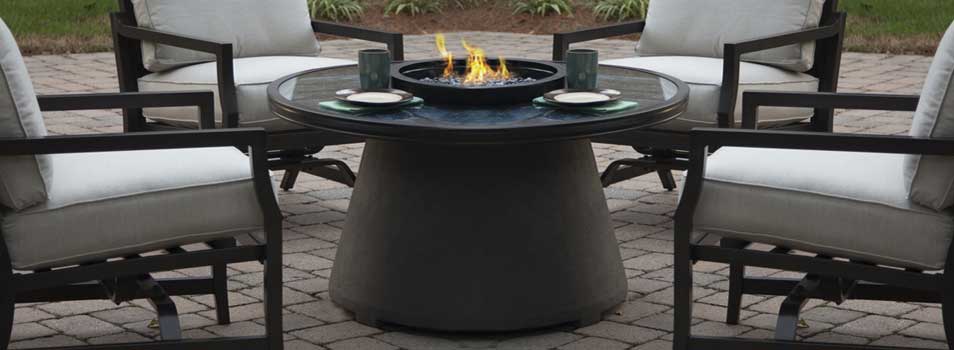Choosing Your Fuel Source: Propane, Natural Gas, Wood, or Bioethanol?

PROPANE

Also known as liquid propane, this fuel source is a popular choice. Propane burns brightly and emits the most heat. Comparatively, you’ll get 2,500 BTUs (British Thermal Units) compared to the same volume of natural gas at 1,000 BTUs. (1)
Propane runs through a hardline (sometimes referred to as HLP) or with a refillable tank. The tank offers versatility because it can be exchanged for a new tank at local grocers and hardware stores when empty, but it may require some creativity to keep the tank out of sight. Some fire pits are sized to allow for hidden propane tanks in their base or may require a specifically sized tank, while others are not designed with an access door. This can be remedied with a simple tank cover that can double as an end table. The tank option also offers some versatility if you’re looking to relocate your fire pit to another part of your outdoor living area.
Due to the density of propane, your fire pit will require an additional component, known as an air mixer, as part of your burner kit. This piece allows air to combine with the propane at the necessary ratio. This is not only a safety benefit but will also create a more beautiful fire.
Advantages
- Burns bright even in well-lit situations
- Most efficient BTU output
- Best heat source
- More versatile because it doesn’t require a hardline
Disadvantages
- Price of fuel fluctuates seasonally
- Tanks require refilling
NATURAL GAS

Natural gas is a common choice for fire pits and especially fireplaces. This fuel type is lighter than air, which means it will dissipate more quickly. Many homes already run on natural gas so there’s no additional system that needs to be put in place, but you will need to run a hardline to your fire feature. Installing a hardline system will require a certified technician to ensure all lines are safely installed to protect you and your family.
This fuel source burns cleaner than propane, creating less black residue (soot) on your fire glass or other fire media. Additionally, natural gas is the most cost-efficient option, making it ideal for many homeowners.
Advantages
- Readily available through your home and doesn’t require refills
- Most cost-efficient fuel source
- Cleaner burning fuel
- Creates a more white-toned fire
Disadvantages
- Requires hardline
- Doesn’t allow for portability
- Requires professional installation
WOOD

Wood fires are a classic choice. Depending on your location, a wood fire pit may be ideal. While it doesn’t allow for the same control as a gas fire, the classic campfire smell can be a treasured memory of time spent with loved ones. But that same smell may be off-putting for others. Wood fires require additional storage space for fire wood, and when you run out, the fun is over. Additionally, storing wood can attract pests that take shelter in the woodpile. But the nostalgic response to a wood fire pit can far outweigh any negatives. Wood fire pits offer a great spot for the family to gather with s’mores in hand.
Advantages
- Affordable
- Wood adds to ambiance
Disadvantages
- Creates a lot of soot and ash
- Leaves smoky odor on clothing
- Can create sparks
- Storing wood can attract pests
BIOETHANOL

Bioethanol fuel, also known as biofuel or simply ethanol, is an eco-friendly solution. This renewable source of energy is created from plant byproduct of such crops as corn, grain, sugarcane, rice, grapes, and more. The crop remnants are fermented with yeast, creating the clean-burning fuel source. When lit, the fuel does not emit a spark or smoke, just flame, steam, and carbon dioxide. The carbon dioxide is then used as a food source for nearby flora.
This fuel is available in liquid or gel form. The type you’ll need will ultimately depend on the fire pit or fireplace you choose. And unlike liquid propane or natural gas that require hardlines or tanks, the simplicity of bioethanol allows you to set up your system anywhere. Many biofuel firepits and freestanding fireplaces offer the flexibility to use your fire feature indoors with minimal ventilation or outdoors, making them a very versatile choice.
However, if you’re looking for heat source more than ambiance in your fire pit or fireplace, you might want to look at another fuel option. Bioethanol gives off very little heat and must be refilled, typically after a few hours of use.
Advantages
- Clean burning with no smoke
- Environmentally friendly
- Versatile – can be used indoors or outdoors
Disadvantages
- Low heat output
- Containers typically run out of fuel after 4 hours
- Costlier option
Ultimately, your decision should be based on your specific needs. Whatever you choose, the staff at Starfire Direct is ready to assist you so you can find the best option for you. Whether it’s a custom fire pit or a freestanding feature, you find the perfect fire feature.




